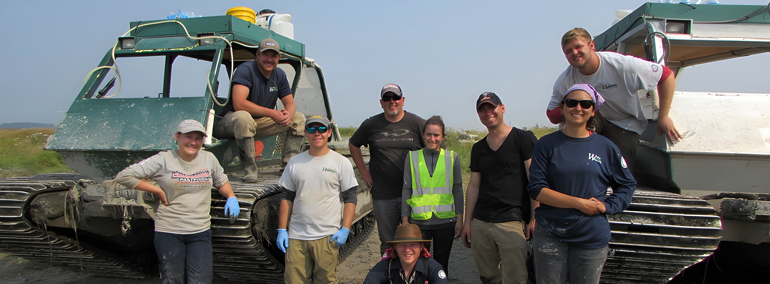
Invasive Species Control
DNR Aquatic Resources Division’s Invasive Species Program (AIS) works with a broad array of public, private and tribal partners throughout the state to control—or eradicate where possible—aquatic invasive plants and animals through a variety of integrated pest management (IPM) techniques to protect and enhance Washington’s valuable aquatic resources on over 2.6 million acres of state-owned aquatic lands (SOAL).
The AIS Program is proud to participate in the Snohomish River Watershed Salmon Recovery Strategy with our WRIA 7 partners. In 2021, AIS provided 12 weeks of Puget SoundCorps (SoundCorps) crew assistance to weed control partners in King and Snohomish Counties. SoundCorps crews assisted with knotweed survey and control on salmon spawning gravels and associated salmon habitat in the Snoqualmie River, Tye River, Skykomish River, and Pilchuck River, all tributaries of the Snohomish River.
Noxious weeds—non-native invasive plants—aren’t just a farm and ranch problem in Washington State; they impact public safety as well as wildlife and aquatic habitats, including habitats used by iconic species such as salmon and tundra swans. These undesirable weedy plant species outcompete more ecologically desirable Pacific Northwest native plants for space, light, and other resources, causing ecological and environmental damage to fisheries, shellfish, recreation, wildlife, and agricultural and forest productivity.
- Spartina is an aggressive non-native saltmarsh grass that crowds out native estuarine vegetation and ravages shellfish, waterfowl, and salmonid feeding and rearing habitat along the Pacific coast, causing economic devastation for coastal communities.
- Flowering rush displaces native vegetation in lakes and along river edges, reducing the overall biological diversity of an ecosystem and providing cover for non-native predatory fish species such as northern pike.
- Submerged non-native invasive plants such as Eurasian milfoil, parrotfeather, and Brazilian elodea produce dense mats of vegetation that rob oxygen from lakes and streams as well as create dense shade, resulting in dead zones that affect native plants and fish.
- Knotweed, reed canary grass, purple loosestrife, and policeman’s helmet choke rivers and streams, competing with native plant species that provide nourishment for local insects, game, and fish, as well as colonizing salmon-spawning gravel streambeds. These emergent weeds also reduce streamflow, accumulating silt and debris that often covers spawning gravels and changes streamflow dynamics.
For more detailed information about these invasive weeds, and many others, please visit our partner links on the right.
AIS contributions to its partners’ efforts include crew assistance or funding for specific projects, as well as participation in a number of Cooperative Weed Management Areas (CWMAs) and regional planning efforts across Washington to support survey, control, and educational outreach programs.
While the focus of AIS is on invasive aquatic plants, the program supports the work of Washington State Dept. of Fish and Wildlife (WDFW) and the Washington Invasive Species Council (WISC) to eradicate or control invasive aquatic animals such as European green crab (Carcinus maenas), northern pike (Esox lucius), and ghost shrimp (Neotrypaea californiensis).
- European green crab disturb eelgrass beds, compete with Dungeness crab for food and habitat, eat juvenile Dungeness crab and salmon, and feed on mussels, clams, and oysters, harming our vibrant aquatic ecosystems and shellfish industry.
- Northern pike is a voracious predator that devours salmon fry and other native fish.
- Ghost shrimp, also known as burrowing shrimp, adversely affect shellfisheries through predation and bioturbation.
AIS works closely with Washington State Department of Agriculture (WSDA), Washington Department of Ecology (Ecology), State and County Noxious Weed Control Boards, Tribes, and other partners for the survey and control of spartina, knotweed, purple loosestrife, flowering rush, and other listed invasive species. DNR also participates in Washington’s clean-boat and ballast water management programs to prevent transportation of aquatic invasive species by recreational, fishing, and commercial vessels.
The AIS program is guided by DNR’s Strategic Plan, RCW 17.10 and RCW 17.26 for noxious weed and invasive species control, and RCW 79.105.030 – Aquatic lands Management Guidelines to accomplish the following:
- Preserve the value and ecological integrity of state-owned aquatic lands by eliminating small-scale noxious weed infestations through Early Detection and Rapid Response (EDRR).
- Eradicate or reduce large-scale infestations to a scale that no longer threatens fish and wildlife habitat, native plants, agriculture, industry, and other ecological and human values.
- Restore aquatic lands where possible.
- Increase public awareness about sustainable natural resource management and the value of aquatic lands to Washington’s communities and economy.
- Build partnerships within DNR and with individuals, organizations, and governments to leverage efforts to achieve a shared vision of healthy habitats for all living creatures, including humans.

